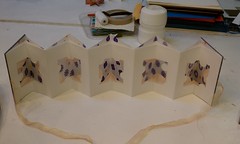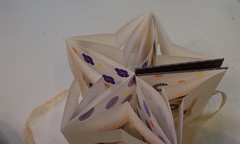Last week I finished a two-part class at the San Francisco Center for the Book which was ostensibly about making multiples of a structure (say, making a bunch of blank journals with the same number of pages and style of binding), but which turned into a guide to making small art books once we exhausted the planned curriculum.

Tiny bits of bookish art
Our teacher owns a small specialty press in the East Bay, and specializes in custom editions of things like invitations. She also makes amazing tiny art books like the one pictured here.
 It was interesting to look at the structures she had made. In some ways, they were clearly books: they had pages and covers, and most of them had text in them, even if it was just something like “Happy New Year! – Jocelyn.” And yet, they’re not quite what I think of as books — they have odd constructions, and are meant to be decorative more than to hold information.
It was interesting to look at the structures she had made. In some ways, they were clearly books: they had pages and covers, and most of them had text in them, even if it was just something like “Happy New Year! – Jocelyn.” And yet, they’re not quite what I think of as books — they have odd constructions, and are meant to be decorative more than to hold information.
What IS a book, exactly?
I’m a big believer in defining my terms! I define a book as: a physical structure which holds information in an easy-to-access, analog format (ie, markings on its surfaces). Books can be made of just about anything, really — metal, vellum, parchment paper, wood, whatever. Those cardboard books designed for babies are still books. I don’t consider an ereader to be a book, though. If it can run out of batteries or break irretrievably when you drop it, it’s not a book, it’s a piece of electronics.
By that metric, these little art books are indeed books — hell, a scroll can be a book, depending on whether you think it’s easy to read a scroll. It’s easy to slide into a philosophical discussion about what is and is not a book. What about those folks who take discarded books and carve them into strange shapes? Are the items they produce still books? I’d say no, as they’re not holding information in markings on their surfaces; they’ve become sculptures, and a sculpture is not a book.
What do you think?
Where do you draw the line between book and not-book?